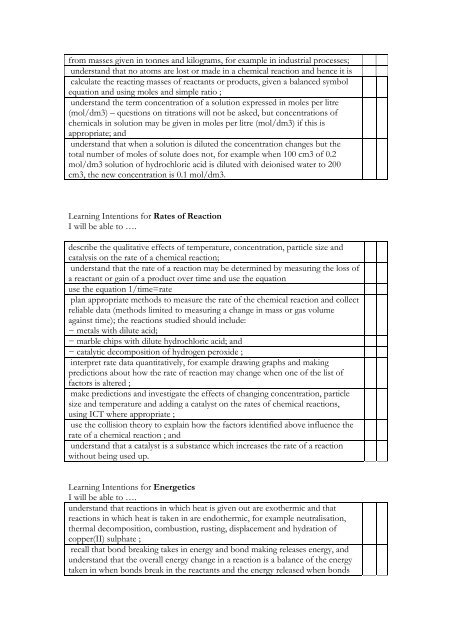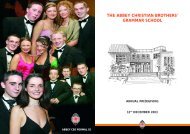GCSE Revision Advice - The Abbey Christian Brothers' Grammar ...
GCSE Revision Advice - The Abbey Christian Brothers' Grammar ...
GCSE Revision Advice - The Abbey Christian Brothers' Grammar ...
Create successful ePaper yourself
Turn your PDF publications into a flip-book with our unique Google optimized e-Paper software.
from masses given in tonnes and kilograms, for example in industrial processes;understand that no atoms are lost or made in a chemical reaction and hence it iscalculate the reacting masses of reactants or products, given a balanced symbolequation and using moles and simple ratio ;understand the term concentration of a solution expressed in moles per litre(mol/dm3) – questions on titrations will not be asked, but concentrations ofchemicals in solution may be given in moles per litre (mol/dm3) if this isappropriate; andunderstand that when a solution is diluted the concentration changes but thetotal number of moles of solute does not, for example when 100 cm3 of 0.2mol/dm3 solution of hydrochloric acid is diluted with deionised water to 200cm3, the new concentration is 0.1 mol/dm3.Learning Intentions for Rates of ReactionI will be able to ….describe the qualitative effects of temperature, concentration, particle size andcatalysis on the rate of a chemical reaction;understand that the rate of a reaction may be determined by measuring the loss ofa reactant or gain of a product over time and use the equationuse the equation 1/time=rateplan appropriate methods to measure the rate of the chemical reaction and collectreliable data (methods limited to measuring a change in mass or gas volumeagainst time); the reactions studied should include:− metals with dilute acid;− marble chips with dilute hydrochloric acid; and− catalytic decomposition of hydrogen peroxide ;interpret rate data quantitatively, for example drawing graphs and makingpredictions about how the rate of reaction may change when one of the list offactors is altered ;make predictions and investigate the effects of changing concentration, particlesize and temperature and adding a catalyst on the rates of chemical reactions,using ICT where appropriate ;use the collision theory to explain how the factors identified above influence therate of a chemical reaction ; andunderstand that a catalyst is a substance which increases the rate of a reactionwithout being used up.Learning Intentions for EnergeticsI will be able to ….understand that reactions in which heat is given out are exothermic and thatreactions in which heat is taken in are endothermic, for example neutralisation,thermal decomposition, combustion, rusting, displacement and hydration ofcopper(II) sulphate ;recall that bond breaking takes in energy and bond making releases energy, andunderstand that the overall energy change in a reaction is a balance of the energytaken in when bonds break in the reactants and the energy released when bonds
















